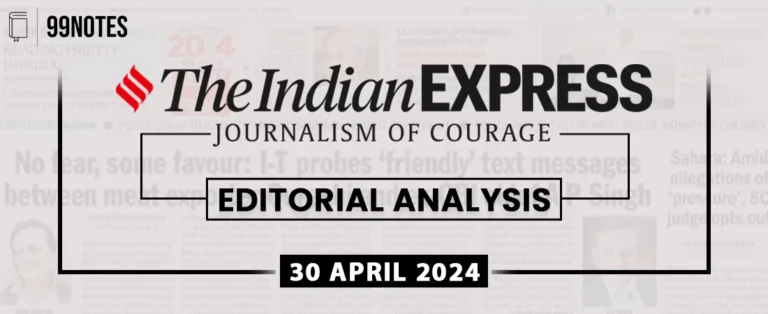8 March 2024 : Indian Express Editorial Analysis
Indian Express Editorial Analysis
8-March-2024
1. The bias that must go
| Topic: GS1 – Society – Role of women and women’s organization
This topic is relevant for both Prelims and Mains in the context of understanding the gender disparities within institutions, including the justice delivery system. |
| Context: |
|
Gender Disparities in the Justice Delivery System:
- The India Justice Report (IJR) reveals a glaring gender gap across various subsystems constituting the justice delivery system, encompassing police, judiciary, prisons, legal aid, and human rights commissions.
- Despite quotas aiding women’s entry, their representation remains disproportionately low, with the majority relegated to lower echelons.
- Statistical data from 2022 highlights alarming figures, indicating a dearth of women in key positions such as judgeships, with only a minimal presence in higher ranks of law enforcement and prison administration.
Institutional Failure to Promote Gender Diversity:
- The lack of gender diversity is evident at all levels of justice administration, with women significantly underrepresented in leadership roles.
- The absence of a woman Chief Justice of India or a substantial number of female judges underscores the institutional reluctance to prioritize gender inclusion.
- Even institutions like the National Human Rights Commission (NHRC) and state commissions exhibit minimal female representation, reflecting a systemic disregard for gender diversity.
Challenges in Policymaking and Implementation:
- Despite acknowledged targets to enhance women’s participation in policing, progress remains sluggish, with only a fraction of women occupying positions within law enforcement agencies.
- While sporadic instances of women attaining prestigious positions surface, they often serve as exceptions rather than indicative of systemic change.
- Women encounter substantial barriers, including biased perceptions and discriminatory practices, hindering their advancement within male-dominated institutional cultures.
Institutional Bias and Deflection of Responsibility:
- The persistent underrepresentation of women reflects entrenched institutional biases, with decision-makers often deflecting responsibility by questioning the feasibility of accommodating more women.
- Such deflections overlook systemic barriers and perpetuate a culture of exclusion.
- Institutions must prioritize addressing gender-based challenges, ensuring inclusivity and equitable opportunities for all genders.
The Imperative for Institutional Transformation:
- Research emphasizes that diversifying institutions enhances internal dynamics and public trust.
- While strides have been made towards inclusion, policy initiatives often fall short of addressing underlying biases and promoting genuine equality.
- To foster a truly inclusive environment, justice administrators must lead by example, reevaluate recruitment practices, and implement measures to support gender diversity effectively.
Conclusion:
- Addressing gender disparities within justice delivery systems necessitates a paradigm shift towards proactive inclusion policies and practices.
- By dismantling institutional barriers and fostering a culture of equality, institutions can uphold core values of justice and equity, ensuring that all genders have equal opportunities to contribute and thrive.
| What is the Global Gender Parity Index (GGPI)? |
What is the Women’s Empowerment Index (WEI)?
|
|
PYQ: Which of the following gives ‘Global Gender Gap Index’ ranking to the countries of the world? (2017)
Ans: (a) |
| Practice Question: Examine the existing disparities and institutional challenges hindering the inclusion of women in key positions within the judiciary, law enforcement, and human rights commissions. Critically evaluate the implications of gender imbalance on the effectiveness and legitimacy of these institutions. (250 words/15 m) |
2. BANKING FOR NET ZERO
| Topic: GS2 – Governance – Government policies – Interventions for development in various sectors
GS3 – Indian Economy – Issues relating to mobilization of resources This topic is relevant for both Prelims and Mains as this analysis delves into the Reserve Bank of India’s initiatives and policies aimed at managing climate-related risks within the banking sector. |
| Context: |
|
Current Exposure and Risk Assessment:
- The Reserve Bank of India (RBI) estimates that Indian banks currently have relatively high exposure to utilities, metal, and transport sectors, posing a notable risk in the context of climate change.
- While the aggregate exposure level remains moderate, disparities exist between public and private sector banks.
- Non-banking financial companies (NBFCs) also extend a significant portion of their credit to sectors such as power and auto, further amplifying systemic risks due to interconnectedness between banks and NBFCs.
Transition Towards Green Investments:
- As fossil fuel-based assets and processes are phased out, there is a growing demand for green investments.
- The RBI is actively focusing on risk management and aligning policies with the transition to net zero.
- Initiatives such as lending to renewable energy under priority sector lending and frameworks for green deposits signify efforts to support sustainable finance.
- Additionally, the RBI’s draft disclosure framework on climate-related financial risks aims to enhance transparency and preparedness among regulated entities.
Disclosure Framework and Risk Assessment:
- The RBI’s disclosure framework sets thematic pillars for reporting, including governance, strategy, and risk management.
- Regulated entities are expected to provide information on internal processes, strategy formulation, and risk assessment related to climate change.
- Stress testing through climate scenario analysis is emphasized, requiring entities to align scenarios with national policies and assess risks across different time horizons.
Metrics and Targets for Reporting:
- Reporting of metrics and targets, such as greenhouse gas emissions and financed emissions, will commence in the financial year 2027-28.
- These metrics are crucial for tracking progress towards sustainability goals and ensuring accountability.
- However, capacity building is identified as a key factor for successful implementation of the framework, considering the varying technical capacities of banks.
Conclusion:
- While the RBI’s draft framework aligns with international standards and signals a significant regulatory shift, it is imperative for regulated entities to monitor asset quality in both fossil fuel-based and green sectors.
- As entities prepare to report under the framework, attention must be paid to capacity building and continuous adaptation to evolving sustainability requirements.
- By proactively addressing climate-related risks and embracing sustainable finance, the banking sector can contribute to a smoother transition towards net zero emissions.
| What is Net Zero Banking Alliance (NZBA) |
|
|
PYQ: The term ‘Intended Nationally Determined Contributions’ is sometimes seen in the news in the context of (2016)
Ans: (b) |
| Practice Question: Discuss the implications of transitioning to net zero emissions on the Indian banking sector. Evaluate the effectiveness of the Reserve Bank of India’s initiatives in managing climate-related risks and fostering green investments. (250 words/15 m) |
For Enquiry

8 March 2024 : The Hindu Editorial Notes PDF

8 March 2024 : PIB Summary for UPSC

8 March 2024 : Indian Express Editorial Analysis

7 Mar 2024 : Daily Current Affairs Quiz

7 Mar 2024 : Daily Answer Writing

7 March 2024 : Daily Current Affairs

7 March 2024 : The Hindu Editorial Notes PDF

7 March 2024 : PIB Summary for UPSC

7 March 2024 : Indian Express Editorial Analysis

6 Mar 2024 : Daily Current Affairs Quiz
March – The Hindu Editorial 8 March 2024 : The Hindu Editorial Notes PDF The Hindu Editorial
8-March-2024
1. A bold step towards a cervical cancer-free future
Topic: GS2…
March 2024 PIB 8 March 2024 : PIB Summary for UPSC PIB Summary for UPSC
8-March -2024
1. Cabinet approves Uttar Poorva Transformative Industrialization…
Indian Express 8 March 2024 : Indian Express Editorial Analysis Indian Express Editorial Analysis
8-March-2024
1. The bias that must go
Topic: GS1 – Society – Role…
Daily Quiz 7 Mar 2024 : Daily Current Affairs Quiz 7 Mar 2024 : Daily Quiz…
mains answer writing 7 Mar 2024 : Daily Answer Writing Mains Answer Writing
7-March-2024
Q1) While decriminalization of politics is crucial, it is equally…
Daily Current Affairs 7 March 2024 : Daily Current Affairs Daily Current Affairs
7-March -2024- Top News of the Day
1. Amit Shah Offers Article 371-like Protections…
March – The Hindu Editorial 7 March 2024 : The Hindu Editorial Notes PDF The Hindu Editorial
7-March-2024
1. The tale of ‘have money, buy miracle drug’
Topic: GS2 – Social…
March 2024 PIB 7 March 2024 : PIB Summary for UPSC PIB Summary for UPSC
7-March -2024
1. Promoting Clean Coal Technology: Coal Gasification
Topic: GS3…
Indian Express 7 March 2024 : Indian Express Editorial Analysis Indian Express Editorial Analysis
7-March-2024
1. The thin-fat Indian
Topic: GS2 – Social Justice…
Daily Quiz 6 Mar 2024 : Daily Current Affairs Quiz 6 Mar 2024 : Daily Quiz…




